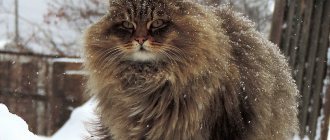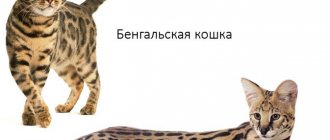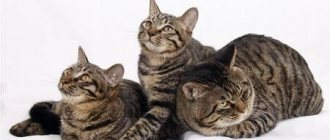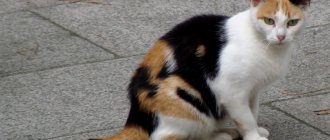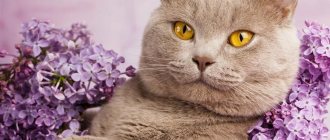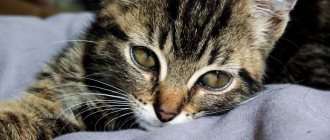Savannah is the name given to a large breed of cat, bred by crossing wild cat servals and familiar domestic cats. The main features of savannahs include their large size, striking resemblance to wild servals, extraordinary devotion, as well as high cost, which reaches 22 thousand dollars. Now these cats are considered the most expensive in the world.
History of the origin of the breed
The origin of the Savannah is unusual, it belongs to the category of short-haired cats, the color of its coat resembles that of a cheetah. The rare features of these cats are explained by their exotic origin. The birth of the breed is usually dated back to the mid-80s of the twentieth century. Breeders from the USA set out to create a completely new breed of large domestic cats that look like cheetahs. Mainly due to the spotty coloration. For this purpose, attempts were made to cross Servals, wild African cats, distant relatives of the lynx, with a characteristic vertical ear arrangement, with domestic cats, Siamese, Bengal, Egyptian Mau and some other short-haired breeds. The serval was chosen as one of the parents not only for its bright appearance, but also for its intelligence, training, and friendliness.
The breeders have done a truly tremendous job. Even the selection of cats for mating in this case is difficult, not to mention the process itself. Representatives of the selected breeds differed greatly in size and temperament.
We recommend reading the article about servals on the Mister Cat portal.
On April 7, 1986, thanks to the efforts of D. Frank, the first pair of kittens was born. The breed standards, which were approved by TICA, were developed by breeders J. Sroufe and P. Kelly. TICA officially recognized the savannah in 2001.
It is interesting that the breed is still not recognized by other organizations of felinologists. It is believed that not enough time has passed for its signs to consolidate; they are unstable in manifestation and the number of savannahs is still small.
How to choose a kitten
Before purchasing a Savannah kitten, you should look at the parents. The main thing you should pay attention to is the living conditions, pedigree and order of the kitten’s generation.
Important! A kitten should be taken as a pet no earlier than the 3rd or 4th generation.
The pet's parents must be purebred, the owner of the kennel must have pedigrees for each manufacturer and veterinary passports confirming the presence of scheduled vaccinations. Animals should not live in cramped conditions.
The optimal age for purchasing a kitten is 3-4 months; by the time of sale, it must be socialized and trained to use a scratching post and litter box. The pet should rumble, purr, make contact easily and be playful. If the kitten is too aggressive, then you should refrain from buying.
A kitten should be picked up only in the presence of the breeder and with a fully drawn up contract, which provides for testing the animal for infectious diseases and the possibility of returning it if the veterinarian’s conclusion is unsatisfactory.
What is the difference between a Savannah and a Bengal cat?
Despite the similarities in appearance, the Savannah cat and the Bengal cat have a number of significant differences.
- The pedigree of Bengal cats originates from the Far Eastern cats, and in the savannas - from African servals.
- If you look closely at Savannahs and Bengals, differences in the coloring of the skin are visible to the naked eye. In Bengals it is dotted with dark spots of three different colors. Savannahs have spots of the same tone.
- Distinctive features are manifested in the structure of the body. The Bengal breed has a compact body, like an American football player. These are cats with small ears and large round eyes. But Savannah is compared to a tall basketball player. They have big ears.
Head and muzzle
The eyes are elongated oval in shape, the color can vary from green to brown, gold to amber, and starting from the sides of the eyes to the whiskers, there are darker markings on the face that are used by Savannahs to prevent them from being blinded. light. solar.
The head should be triangular in shape,
- Slightly smaller than the body, and the ears should be large and wider at the base and rounded at the tip; To
- In addition, they must have the typical ocelli on the back, which is characterized by a central stripe along the spine,
- Bordered with black, brown or gray streaks that almost form the shape of an eye.
Appearance
According to established standards, these cats have a flexible, slender, elongated body. The cat looks heavier than it actually is. It stands out for its very large, rounded ears. Limbs are long and strong. The hind legs are longer than the front legs, like those of large cats. The tail is long and straight. The short fur of a Savannah kitten is very soft and thick. The undercoat is soft, dense, evenly distributed throughout the body. Another feature is that the paws are round, small in size, and colored charcoal or dark brown. Savannah is distinguished by its noble posture and natural grace. Unlike the British, who are considered to be such “bumps” in the cat world.
Standard colors: cinnamon tabby, chocolate, gold-silver, brown.
The largest representative of domestic cats. Height at the withers is up to 60 cm, weight is 13-15 kg. They reach their maximum size at 3 years. Savannahs live for about 15 years.
Dimensions and contents
On average, these cats are more than a meter long and weigh up to fifteen kilograms. Due to these characteristics, the Savannah should only live in large spaces, since the specimen can jump from a standstill to a height of up to two meters, a distance that can easily be achieved with a simple click.
The innate wildness of this species requires large spaces in which the big cat can live and move freely.
After all, this shouldn't come as a surprise, given that the blood of servals, the most impressive wild cats in the Serengeti, flowing through their veins, weighing 18 kg and more than 120 cm in length. The tail is not very long, of medium thickness, with a black and slightly blunt tip.
Character
Character is influenced by 3 main factors: parental behavior, generation, socialization. Since the breed is still at an early stage of development, animals of different generations differ significantly in character.
The first generation Savannah cat (F1 or F2) will behave more actively and even wildly. This is reflected in the nature of servals, which are characterized by jumping, hunting and tracking. Fertile F5 and F6 cats are already used for breeding. The resulting offspring has a character more familiar to all owners of domestic cats. But, nevertheless, all generations are characterized by excessive curiosity and high activity.
An interesting combination of love of freedom and easy-going characterizes all cats of the Savannah breed.
They adapt well to various conditions, show interest in things around them, and tolerate coexistence with other pets.
These cats are extremely mobile, jumping, and require a lot of space for a comfortable life. Unlike other cats, they are not only not afraid of water, but enjoy bathing. They even prefer to drink ordinary water from large containers, which apparently remind them of the reservoirs familiar to their ancestors. These cats do not protest when they are walked on a leash, which once again demonstrates their “dog-like” character.
The main characteristic is devotion, which is often compared to that of a dog. Wagging the tail as a greeting is also more of a dog than a cat sign.
Such cats get along with children from 5 years old (but not with toddlers), because they are calm and enjoy playing for hours on end. They have a high level of intelligence (some felinologists highlight this trait significantly) and are trainable. But they also require a lot of attention.
When raising them, it is important to take into account that they need early socialization. Kittens that communicate with people from their first days quickly get used to life in a family, learn behavior and habits. But in one litter there can be both more active and sociable kittens and more timid ones. Therefore, you need to communicate with the latter, play more actively, and encourage them more often than active, fearless kittens.
Savannah breed cost
Savannah breed
The price of Savannah F1 ranges from approximately 400,000 to 1,000,000 rubles. On the European market, the cost of this breed varies from $7,500 to $22,000. However, I have seen advertisements from nurseries for 200,000 thousand rubles, but in such cases I still advise you to consult professionals, since some breeders pass off third-generation Savannahs as F1 offspring. Be careful!
According to the latest data, prices for Savannah cats are as follows: Savannah males:
- F1 from $7,500 to $22,000
- F2 from $4,500 to $16,000
- F3 from $3,000 to $6,000
Savannah females:
- F1 from $6,000 to $22,000
- F2 from $4,500 to $14,000
- F3 from $3,500 to $5,500
In European and American catteries, most kittens will be sterilized before sale unless they are specifically intended for breeding. Kittens sold for breeding usually cost slightly more than those purchased solely as pets. The author of the article does not know the rules for the sale of Savannah cats in Russia, Ukraine and other CIS countries.
Why are savannas expensive?
Savannah F1
People often ask why the Savannah cat is so expensive. Understanding the breeding challenges of this breed will help you appreciate just how special your new pet is.
It often happens to breeders that it takes a lot of time and money to find cats suitable for breeding. A breeder may have to go through many females before a Serval cat recognizes a female as suitable for mating. The gestation period, which is about two weeks less than that of the Serval, is also a problem. Kittens may be born prematurely and require extra care to survive and remain healthy.
Some breeders report that premature births are common in early generations. Savannah kittens may also be too big to give birth naturally and require a C-section!
Savannah litters also tend to have a minimum survival rate of 0-3 kittens. Breeders may have spent as much as $100,000 before their first viable kitten is born and ready for a healthy life.
Pros and cons of the breed
Pros:
- Non-standard, exotic appearance.
- Intelligence and natural curiosity.
- Unlimited loyalty to the owners.
- They are easy to train.
- Relatively unpretentious in care.
- Peaceful - gets along well with other cats and dogs.
- They quickly adapt to new conditions, so they are easy to travel with.
Minuses:
- High price.
- You need to walk them a lot, like dogs.
- Sometimes extremely mobile.
- Willful and independent.
- Due to its large size and active behavior, it is not recommended to have it in a home with small children.
Diseases
When you look at these lean, energetic creatures, it seems that diseases avoid them. This is partly true: savannahs retain mobility and flexibility of joints, animal instincts and a sharp mind until a very old age. Their excellent immunity allows them to quickly cope with fungal and viral infections and heal wounds. But sometimes representatives of this breed also have defects.
One of the most common is the “cleft palate” - a cleft palate. This can only be dealt with surgically. Sometimes kittens are diagnosed with hydrocephalus or dwarfism. But such cases are so rare that they are the exception, not the rule.
Savannahs, like other cats, should be up to date on vaccinations against rabies and other dangerous diseases, as well as given anti-worm medications.
Individuals of classes F1, F2, F3 and F4 are sterile, but F5 males are allowed to mate with other cats (it is not prohibited to breed a cat with ordinary outbreds, but breeders prefer Egyptian Mau, Ocicat and Bengal).
Breeding and care
Descendants from crossing servals with domestic shorthair cats, Bengal, Siamese, Egyptian Mau and others are designated F1 (that is, descendants of the first generation). They have 53% blood of wild servals. All males, up to the fourth generation, are sterile. Each subsequent generation is designated by the F indicator with the corresponding numerical index. The descendants of F2 have only 29% Serval blood, and so on down the line, down to F7. The higher the percentage of Serval blood in the descendant, the more similar in appearance it will be to him. Savannahs designated F1-F3 are descendants of earlier generations. For them, the percentage of Serval blood is indicated in parentheses after the generation designation. They are the ones most valued by breeders of the breed and those wishing to acquire kittens.
To overcome physiological and behavioral problems, partners selected for mating are kept together from childhood. Significant biological differences between breeding breeds also affect the bearing of offspring.
This breed is unpretentious. Savannahs do not require special care. You just need to brush them regularly. It is advisable to equip a special enclosure, spacious enough, with equipment for climbing and jumping. The enclosure should only be used for its intended purpose—for cat walks. But in no case for permanent stay, since they value freedom of movement and will not tolerate confinement.
Colors
The standard allows 4 colors:
- Silver spotted.
- Black.
- Black smoky.
- Brownie tabby spotted.
The spots on the skin are black or dark brown. There should be contrasting stripes on the back (from the back of the head to the shoulder blades).
In the photo there are Savannah breed windows of popular colors: silver spotted, black smoky, brown tabby spotted
Nutrition and health
Savannahs are recommended to eat a balanced diet, preferably premium food. It is important to avoid high grain content and it is advisable to add taurine to your food. A little fresh meat in their daily diet prolongs their life.
You should not offer these cats fermented milk products - it may cause stomach upset. Free and constant access to clean water is required.
Savannah cats have good health and immunity. It is possible that this is due to the breeding characteristics of the breed. They only note that in older age they sometimes develop complications with liver function. Similar problems are typical for the serval.
Do not neglect vaccination against diseases common to all cats. In addition, this is still a domestic cat, so it is important to carefully examine it after returning from walks.
Body structure
The Savannah inherited from the Serval a slender, lean body and strong long legs, as well as a spotted coat: In fact, the Serval is distinguished by a brown-orange coat with large black spots.
- However, the gigantic size of the first generation individuals decreases with increasing generations: Already the fifth generation Savannah will be slightly larger than that of an ordinary domestic cat.
- The TICA breed standard states that the typical Savannah has a rectangular, long and muscular body with a strong bone structure and long, thin but powerful legs and small feet with long toes.
The coat color can be spotted brindle with brown, silver brindle with dark gray or black and silver with black spots, but snow, blue and harlequin are also acceptable.
Features of caring for savannah
Before moving your pet into your home, you should prepare everything - remove fragile objects dear to your heart from the shelves, hide wires, install a cat station. It is advisable to equip the trash can with a tight-fitting lid - your pet will certainly explore every corner. For a cat you need to buy:
- large bed;
- harness;
- spacious tray, scoop, filler;
- bowls for food and water;
- toys – balls, mice;
- hair care products;
- nail clipper
Savannah cat playing in the water
Caring for this cat is easy. Short hair is combed once a week, and during shedding, it is brushed over it daily with a rubber brush. In most cases, Savannahs love to bathe and swim if they are accustomed to this from an early age. Be sure to check this point with the nursery owner. The recommended frequency of water procedures is once a month or as needed.
Attention! Savannah cats are easily litter trained, and some cats go to the toilet. You can try to teach your pet to use the human toilet. The main thing in this matter is patience.
Nails are trimmed once every 10 days. It is necessary to monitor the condition of the ears - dirt should not accumulate inside. The external auditory canal is carefully cleaned with a cotton pad soaked in hydrogen peroxide or another antiseptic. Dry dental food is used to remove plaque from teeth.
Feeding recommendations
In the wild, servals feed on rodents and birds. Veterinarians recommend including raw meat or minced meat in the diet of Savannah cats at least 2-3 times a week. The rest of the time, the pet is given super-premium industrial food with a minimum amount of plant components in the composition. Suitable food is intended for large breeds - Maine Coons and Norwegian forest cats.
Savannah cats include meat in their diet
Prohibited products:
- pork;
- any fish;
- spicy, salty, fatty, fried foods;
- sweets, baked goods.
Attention! Veterinarians recommend feeding savannah with vitamin and mineral complexes. They should include amino acids, vitamins B, A, E.
Description of the breed with photographs
The appearance of the animal depends on the classification of the hybrid. The first generation of kittens from crossing a serval with a Bengal cat is designated F1, the second – F2, the third – F3. The lower the number after the letter F, the more genes the animal has from an African wild cat.
F1 kittens contain 50% Serval blood. The second generation of Savannahs has only 29% Serval blood, while the F3 litter has no more than 13%. The next generations are not recognized by most felinological organizations. All subsequent generations are almost no different in appearance from a domestic cat, but if they are crossed again with a serval, the kittens that are born will inherit 70–80% of the characteristics of an African cat.
Savannah exterior
Let's consider the requirements of the standard using the example of the first generation F1 hybrid. In the photo, Savannah cats are quite large animals, reaching a length of 90–100 cm. The weight of a male is 13–14 kg, a female is 8–9 kg.
Exterior standard:
- the body is graceful, elongated, flexible, with well-developed muscles;
- the chest and shoulder girdle are wider than the pelvis;
- the small head is wedge-shaped, the muzzle is elongated;
- cheekbones and belly pads do not stand out;
- the nose is massive, the bridge of the nose is quite wide;
- the eyes are large, the lower eyelids are almond-shaped, the upper ones resemble a boomerang;
- there are dark spots on the inner corners of the eyes that look like tear tracks;
- the iris can be colored yellow, green, amber and gray-blue, eye color is not tied to coat color;
- large ears are set high and located close to each other, the tips are rounded;
- chin small, rounded;
- long, well-muscled neck, smoothly turning into the chest;
- the limbs are thin, graceful, high, the hind legs are longer than the front;
- small oval-shaped paws with powerful toes and strong claws;
- a medium-thick tail should ideally reach the hocks.
The main reasons for the disqualification of Savannahs are polydacty, small ears, and color defects. Individuals with behavior characteristic of wild cats and displaying aggression towards people are not allowed to participate in exhibitions and breeding.
Colors
The Savannah's coat is quite thick and consists of strong guard hairs and soft undercoat. The pattern on the body resembles a cheetah - spots in the form of strokes are scattered throughout the body. On the stomach and chest they are smaller, on the back they are larger. Their shade always varies from dark brown to black.
The standard provides for several types of color for Savannah cats:
- tabby cinnamon;
- chocolate;
- gold;
- silver;
- brown.
Attention! Representatives of this breed should not have white medallions or tiger stripes on their coat.
Character and habits
The character of the savannah is revealed by its relationship with wild cats. These are freedom-loving and fairly independent animals, endowed with high intelligence. They will never become like a sofa cushion. It is also unlikely that they will be used as interior decoration - savannahs are very mobile. They love to run, play, and hunt, which is quite natural for cats, whose closest relatives are wild animals.
Savannah cat silver color
Kittens are active and inquisitive, playful and affectionate. Experienced breeders advise holding the baby more often, sleeping with him, and communicating so that the pet grows up surrounded by love. This will help strengthen trust in the owner and socialize faster. First generation hybrids may be wary of strangers.
Relationships with other animals are difficult, because representatives of this breed are leaders and do not tolerate competition. However, even pets with wayward characters can change after the castration procedure. They will become more balanced and calm, the passion for dominance will subside.
Savannah is a cat with a high level of intelligence, which is easy to teach different commands. The owners of these animals claim that their pets can fetch a ball and give a paw, like dogs. If desired, you can teach your pet more complex tricks. When raising a cat, you should not show aggression or behave rudely - savannah cats require respectful treatment.
Hunter skills are highly developed in 1st and 2nd generation hybrids. The pet can get carried away and begin to hunt its owner's feet. This behavior needs to be stopped from childhood. It is important to give your cat the opportunity to express his energy in another way. Savannahs are large, so they need a lot of free space for active play. The best place to keep a pet would be a large house with a yard.
Savannah - big cats
If the animal is kept in an apartment, you will have to buy a large cat complex for it. You will also need a lot of toys, including interactive ones, so that your pet doesn’t get bored. Walking on a harness is necessary for a pet who lives in an apartment building. Walking is allowed in dry, warm weather. In winter, you can go outside if there is no wind and the thermometer is above –5 ºС.
Attention! Savannah cats cannot stand being alone. You shouldn't have a pet if work takes up most of your time.
Hybrids F1 and F2 tend to become attached to one family member and are very sensitive to separation from the owner. Savannah will need a lot of time to get used to a new owner if she has to part with her old one. For the same reason, kittens from the nursery do not make contact with family members for a long time in the first weeks of life in the house. Adaptation may take 1–2 weeks, and in some cases up to a month.
Health and life expectancy
Savannah cats live about 18–20 years. Surprisingly, the hybrid has no specific diseases. In rare cases, kittens are born with extra toes or a cleft palate. Some individuals suffer from hydrocephalus.
Savannah cat on the walk
A pet needs vaccination, just like a regular house cat. Twice a year she is dewormed and periodically treated for skin parasites - fleas and ticks. At the slightest sign of illness, your pet should be taken to the veterinarian so that treatment can be started on time if necessary. Deterioration in health is indicated by decreased activity, loss of appetite, excessive shedding, and strange behavior.

